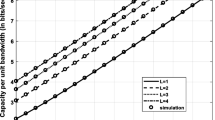Abstract
Wireless communications systems in a frequency reuse environment are subject to cochannel interference. In order to improve the system performance, diversity techniques are deployed. Among the practical diversity schemes used, Equal-Gain Combining (EGC) appears as a reasonably simple and effective one. Unfortunately, the exact analysis of the outage probability of EGC receivers is rather intricate for it involves the evaluation of multifold nested integrals. It becomes mathematically intractable with the increase of the number of diversity branches and/or interferers. For example, for N B diversity branches and N I arbitrary independent cochannel interferers, the exact formulation using the convolutional approach requires 2 + N B + (N B × N I ) nested integrals, which, very quickly, and for any practical system, turns out to be mathematically intractable. In this paper, we propose accurate approximate formulations for this problem, whose results are practically indistinguishable from the exact solution. In our model, the system is composed by N B branches and N I interferers so that the desired signals are coherently summed, whereas the interfering signals are incoherently summed at the EGC receiver. Three sets of fading scenarios, namely α-μ , κ-μ, and η-μ, are investigated. The proposed approach is indeed flexible and accommodates a variety of mixed fading scenarios for desired and interfering signals.
Similar content being viewed by others
References
Sowerby K. W., Williamson A. G. (1988) Outage probability calculations for multiple cochannel interferers in cellular mobile radio systems. Proceedings Institute of Electrical Engineering—Radar and Signal Processing 135(3): 208–215
Yao Y. -D., Sheikh A. U. H. (1992) Investigations into cochannel interference in microcellular mobile radio systems. IEEE Transactions on Vehicular Technology 41(2): 114–123
Proakis J. G. (2001) Digital communications. McGraw-Hill, New York
Nakagami, M. (1960) The m-distribution: A general formula of intensity distribution of rapid fading. In Hoffman, W. C. Statistical methods in radio wave propagation. Pergamon, Elmsford, NY
Reig J., Cardona N. (2000) Nakagami-m approximate distribution of sum of two correlated Nakagami-m correlated variables. IET Electronics Letters 36(11): 978–980
Hu J., Beaulieu N. C. (2005) Accurate simple closed-form approximations to Rayleigh sum distributions and densities. IEEE Communications Letters 9(2): 109–111
Hu J., Beaulieu N. C. (2005) Accurate closed-form approximations to Ricean sum distributions and densities. IEEE Communications Letters 9(2): 133–135
Santos Filho J. C. S., Yacoub M. D. (2006) Simple precise approximations to Weibull sums. IEEE Communications Letters 10(8): 614–616
Santos Filho J. C. S., Yacoub M. D. (2004) Nakagami-m approximation to the sum of M non-identical independent Nakagami-m variates. IET Electronics Letters 40(15): 951–952
Santos Filho J. C. S., Yacoub M. D. (2005) Highly accurate κ−μ approximation to sum of M independent non-identical Ricean variates. IET Electronics Letters 41(6): 338–339
Santos Filho J. C. S., Yacoub M. D. (2005) Highly accurate η−μ approximation to the sum of M independent non-identical Hoyt variates. IEEE Antennas and Wireless Propagation Letters 4: 436–438
Coleman T. F., Li Y. (1996) An interior trust region approach for nonlinear minimization subject to bounds. SIAM Journal on Optimization 6: 418–445
Shah A., Haimovich A. M. (2000) Performance analysis of maximal ratio combining and comparison with optimum combining for mobile radio communications with cochannel interference. IEEE Transactions on Vehicular Technology 49(4): 1454–1463
Aalo V. A., Zhang J. (2001) Performance analysis of maximal ratio combining in the presence of multiple equal-power cochannel interferers in a Nakagami fading channel. IEEE Transactions on Vehicular Technology 50(2): 497–503
Yang L., Alouini M.-S. (2004) On the average outage rate and average outage duration of wireless communication systems with multiple cochannel interferers. IEEE Transactions on Wireless Communication 3(4): 1142–1153
Abu-Dayya A. A., Beaulieu N. C. (1992) Outage probabilities of diversity cellular systems with cochannel interference in Nakagami fading. IEEE Transactions on Vehicular Technology 41(4): 343–355
Song Y., Blostein S. D., Cheng J. (2003) Exact outage probability for equal gain combining with cochannel interference in Rayleigh fading. IEEE Transactions on Wireless Communication 2(5): 865–870
Hadzi-Velkov Z. (2007) Level crossing rate and average fade duration of EGC systems with cochannel interference in Rayleigh fading. IEEE Transactions on Communication 55(11): 2104–2113
Tellambura C., Annamalai A. (2000) Further results on the Beaulieu series. IEEE Transactions on Communication 48(11): 1774–1777
da Costa D. B., Yacoub M. D., Santos Filho J. C. S. (2008) Highly accurate closed-form approximations to the sum of α−μ variates and applications. IEEE Transactions on Wireless Communication 7(9): 3301–3306
da Costa D. B., Yacoub M. D. (2009) Accurate aproximations to the sums of generalized random variables and applications in the performance analysis of diversity systems. IEEE Transactions on Communication 57(5): 1271–1274
Yacoub M. D. (2007) The α−μ distribution: A physical fading model for the Stacy distribution. IEEE Transactions on Vehicular Technology 56(1): 27–34
Yacoub M. D. (2007) The κ−μ distribution and the η−μ distribution. IEEE Antennas and Propagation Magazine 49(1): 68–81
Abramowitz M., Stegun I. A. (1972) Handbook of mathematical functions with formulas, graphs, and mathematical tables. Dover, New York
Jiménez D. M., Paris J. F. (2010) Outage probability analysis for η− μ fading channels. IEEE Communications Letters 14(6): 521–523
Simon M. K., Alouini M. -S. (2000) Digital communications over fading channels: A unified approach to performance analyis. Wiley, New York
Tellambura C., Annamalai A. (1999) An unified numerical approach for computing the outage probability for mobile radio systems. IEEE Communications Letters 3(4): 97–99
Author information
Authors and Affiliations
Corresponding author
Rights and permissions
About this article
Cite this article
Moraes, A.C., da Costa, D.B. & Yacoub, M.D. An Outage Analysis of Multibranch Diversity Receivers with Cochannel Interference in α-μ, κ-μ, and η-μ Fading Scenarios. Wireless Pers Commun 64, 3–19 (2012). https://doi.org/10.1007/s11277-012-0513-x
Published:
Issue Date:
DOI: https://doi.org/10.1007/s11277-012-0513-x




